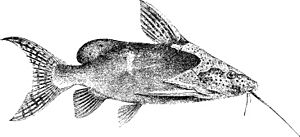Synodontis nigrita facts for kids
Quick facts for kids Synodontis nigrita |
|
|---|---|
 |
|
| Conservation status | |
| Scientific classification | |
| Synonyms | |
|
Synodontis fascipinna Nichols & La Monte, 1953 |
The Synodontis nigrita, also called the false upside-down catfish, is a type of upside-down catfish. It lives in many parts of northern Africa. A French zoologist named Achille Valenciennes first described this fish in 1840.
Contents
What Does the False Upside-Down Catfish Look Like?
Like other Synodontis fish, the false upside-down catfish has a strong, bony head. This bony part goes all the way back to its first dorsal fin spine.
Special Features of the Head
The fish has a unique bony bump on its head called a humeral process. This bump helps scientists tell different Synodontis species apart. For the false upside-down catfish, this bump is longer than it is wide. It also has a ridge on the bottom and a pointy back end.
Whiskers (Barbels)
This catfish has three pairs of whiskers, called barbels. One pair is on its upper jaw, and two pairs are on its lower jaw.
- The upper jaw whiskers are long and straight. They can be about 1 to 1.6 times the length of its head.
- The outer pair of lower jaw whiskers is twice as long as the inner pair. Both pairs have small, simple branches.
Fins and Spines
The front edges of the dorsal fin (on its back) and pectoral fins (on its sides) are stiff spines.
- The dorsal fin spine is mostly straight. It is about 0.75 to 1 times the length of its head. The front of this spine is smooth, but the back has small teeth-like bumps. The rest of the dorsal fin has seven soft rays.
- The pectoral fin spine is similar in size to the dorsal spine. It has small teeth-like bumps on both sides.
- The adipose fin (a small, fleshy fin near the tail) is about 2.6 to 3 times longer than it is deep.
- The anal fin (on its belly near the tail) has four unbranched and eight or nine branched rays.
- The tail, or caudal fin, is deeply split into two parts. The top part is a bit longer.
Teeth and Mouth
All Synodontis fish have a special pad of teeth on their upper jaw. These teeth are short and shaped like chisels. In the false upside-down catfish, this tooth pad is short and wide. On its lower jaw, the teeth are hooked or S-shaped. They are attached to flexible stalks. The number of teeth helps identify the species. The false upside-down catfish usually has about 30 to 35 teeth on its lower jaw.
Color and Size
The body of this fish can be brown, olive green, or blackish. It often has round black spots. Its fins are greyish to blackish. The tail fin may have black spots or black stripes. Young false upside-down catfish are brown with black spots.
This species can grow up to about 33.5 centimetres (13.2 in) long. Female Synodontis fish are usually a bit bigger than males of the same age.
Where Does the False Upside-Down Catfish Live?
The false upside-down catfish lives in many rivers and lakes across northern Africa.
- In central Africa, you can find it in the Ubangui River and the central Congo River basin.
- In eastern Africa, it lives in Lake Albert and possibly Lake Kyoga.
- In northern Africa, it might be found in Egypt.
- In northeast Africa, it lives in the White Nile river system and the Baro River.
- In western Africa, it is known from the Chad River, Niger River, Volta River, Senegal River, Gambia River, Geba River, Oueme River, and Casamance River.
What Does the False Upside-Down Catfish Eat?
Synodontis species are omnivores, meaning they eat both plants and animals. They eat things like:
- Insect larvae (baby insects)
- Algae (tiny water plants)
- Snails and clams
- Sponges
- Small crustaceans (like tiny shrimp)
- Eggs of other fish
Life Cycle and Behavior
Scientists don't know much about how most Synodontis species reproduce. However, they believe spawning (laying eggs) likely happens during the flooding season, from July to October. During this time, pairs of fish might swim together to lay eggs. These fish grow quickly in their first year, then their growth slows down as they get older.
See also
- List of freshwater aquarium fish species


